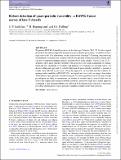Files in this item
Robust detection of quasi-periodic variability : HAWK-I mini survey of late-T dwarfs
Item metadata
| dc.contributor.author | Littlefair, S.~P. | |
| dc.contributor.author | Burningham, B. | |
| dc.contributor.author | Helling, Ch. | |
| dc.date.accessioned | 2018-11-01T10:30:10Z | |
| dc.date.available | 2018-11-01T10:30:10Z | |
| dc.date.issued | 2017-05-01 | |
| dc.identifier | 256402014 | |
| dc.identifier | af8871a5-7d50-47c5-855a-e5bab8d6cd9f | |
| dc.identifier | 000402849400034 | |
| dc.identifier | 85039453997 | |
| dc.identifier.citation | Littlefair , S P , Burningham , B & Helling , C 2017 , ' Robust detection of quasi-periodic variability : HAWK-I mini survey of late-T dwarfs ' , Monthly Notices of the Royal Astronomical Society , vol. 466 , no. 4 , pp. 4250-4258 . https://doi.org/10.1093/mnras/stw3376 | en |
| dc.identifier.issn | 0035-8711 | |
| dc.identifier.other | Bibtex: urn:70db061d614d1d824dea3463d5b33cbf | |
| dc.identifier.uri | https://hdl.handle.net/10023/16368 | |
| dc.description | SPL is supported by STFC grant ST/M001350/1. BB acknowledges financial support from the European Commision in the form of a Marie Curie International Outgoing Fellowship (PIOF-GA-2013-629435). Based on observations made with ESO Telescopes at the La Silla Paranal Observatory under programme ID 090.C-0721. ChH highlights financial support of the European Community under the FP7 by the ERC starting grant 257431. | en |
| dc.description.abstract | We present HAWK-I J-band light curves of five late-type T dwarfs (T6.5–T7.5) with a typical duration of 4 h and investigate the evidence for quasi-periodic photometric variability on intra-night time-scales. Our photometry reaches precisions in the range 7–20 mmag, after removing instrumental systematics that correlate with sky background, seeing and airmass. Based upon a Lomb–Scargle periodogram analysis, the latest object in the sample – ULAS J2321 (T7.5) – appears to show quasi-periodic variability with a period of 1.64 h and an amplitude of 3 mmag. Given the low amplitude of variability and presence of systematics in our light curves, we discuss a Bayesian approach to robustly determine if quasi-periodic variability is present in a light curve affected by red noise. Using this approach, we conclude that the evidence for quasi-periodic variability in ULAS J2321 is not significant. As a result, we suggest that studies which identify quasi-periodic variables using the false alarm probability from a Lomb–Scargle periodogram are likely to overestimate the number of variable objects, even if field stars are used to set a higher false alarm probability threshold. Instead we argue that a hybrid approach combining a false alarm probability cut, followed by Bayesian model selection, is necessary for robust identification of quasi-periodic variability in light curves with red noise. | |
| dc.format.extent | 9 | |
| dc.format.extent | 3176910 | |
| dc.language.iso | eng | |
| dc.relation.ispartof | Monthly Notices of the Royal Astronomical Society | en |
| dc.subject | Brown dwarfs | en |
| dc.subject | QB Astronomy | en |
| dc.subject | QC Physics | en |
| dc.subject | DAS | en |
| dc.subject.lcc | QB | en |
| dc.subject.lcc | QC | en |
| dc.title | Robust detection of quasi-periodic variability : HAWK-I mini survey of late-T dwarfs | en |
| dc.type | Journal article | en |
| dc.contributor.sponsor | European Research Council | en |
| dc.contributor.institution | University of St Andrews. St Andrews Centre for Exoplanet Science | en |
| dc.contributor.institution | University of St Andrews. School of Physics and Astronomy | en |
| dc.identifier.doi | https://doi.org/10.1093/mnras/stw3376 | |
| dc.description.status | Peer reviewed | en |
| dc.identifier.url | https://arxiv.org/abs/1703.01245 | en |
| dc.identifier.grantnumber | 257431 257431 | en |
This item appears in the following Collection(s)
Items in the St Andrews Research Repository are protected by copyright, with all rights reserved, unless otherwise indicated.

